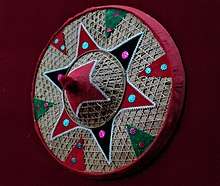Jaapi
The jaapi or japi (Assamese: জাপি; Bodo: Khomfri) is a traditional conical hat from Assam, India similar to the Asian conical hat which is made from tightly woven bamboo and/or cane and tokou paat (Trachycarpus martianus) a large, palm leaf. The word jaapi derives from jaap meaning a bundle of taku leaves.[1] In the past, plain jaapi were used by ordinary people in Assam and by farmers for protection from the sun, while ornate jaapi were worn as a status symbol by Assamese royalty and nobility. Decorative sorudoi jaapi are made with intricate cloth designs (primarily red, white, green, blue, and black) that are integrated into the weaving.


Japis have been recorded as far back as the time of Xuanzang's visit to Assam when visitors were welcomed with colorful jaapi.[2] The Chutia kings (a sub-group of Bodo-Kacharis) are also said to have used Jaapi as a cultural symbol. The last Chutia king Nitipal had given two gold and silver embroidered Japis to the Ahom king as gifts in his attempts for a treaty.[3][4] Besides this, after annexing Sadiya, the Ahom king received much treasure and bounty among which included Japis.[5] During the Ahom rule, Japi-hajiya Khel(guild for making Japis) was monopolised by Chutias, which indicate that they were experts in weaving Japis.[6] It is also well known that the Chutia brides wore a Sorudoi Japi during the marriage ceremonies which was continued up until recently.[7] Bishnu Prasad Rabha added Japi dance to Assamese culture through Jaymati movie from Bodo community's Khomfri Sibnai Mwsanai. Originally Japi was an agricultural headgear by farmers to protect themselves from rain or sun's heat. The Bodo-Kacharis having agricultural as the main profession often used them in the rice fields. Similar headgears are also seen to be used all throughout East Asia.[8]
Today the jaapi is a symbol of Assam. It is worn in a style of Bihu dance, used as protection against the elements, offered as a sign of respect in ceremonies, and placed as a decorative item around the house, especially in the walls as a welcome sign.
Types
- Sorudoi japi: Used by women, especially brides.
- Bordoi japi: Used by royalty since ancient times (Kamrupa).
- Panidoi/Haluwa japi:Used by farmers in fields.
- Garakhiya japi: Used by cattle herders.
- Pitha japi: Used as hoods, sometimes during cultivation.
- Tupi/Varun japi: Used in rain as protective hats.

See also
- Conical Asian hat
- Culture of Assam
- List of hats and headgear
- Textiles and dresses of Assam
Notes
- "Crafts of North-East - BAMBOO AND CANE CULTURE OF ASSAM". Ignca.nic.in. Retrieved 9 May 2012.
- "Bamboo products of Assam". Vedanti.com. 8 February 2011. Retrieved 9 May 2012.
- Khanikar,S. Chutia Jaatir Itihax aru Luko-Sanskriti,1991, p.100.
- "Then the Chutiâ king desired to send one silver lipped umbrella (Jâpi), silver and gold bracelets, a gold pirâ, an elephant, and two Âroans to the Ahom king."
- Mahanta,S. Assam Buranji.D.H.A.S.,1945, p.10.
- http://ignca.gov.in/Asi_data/72269.pdf Dutta,S. Mataks and their Kingdom, 1985, p.30
- Khanikar,S. Chutia Jaatir Itihax aru Luko-Sanskriti,1991, p.387.
- শান্তনু কৌশিক বৰুৱা (2001). অসম অভিধান. বনলতা. pp. ১৪৪-১৪৬.